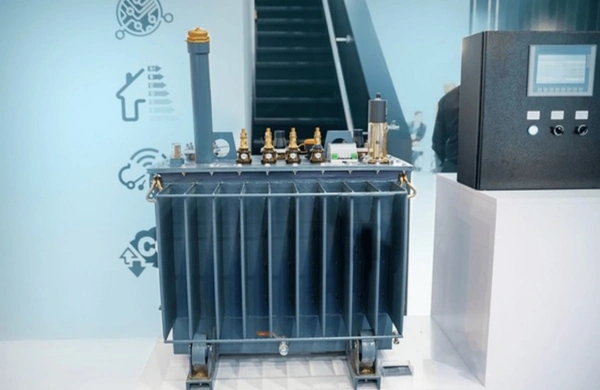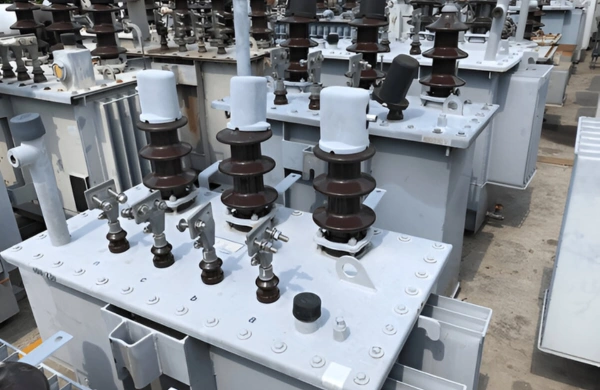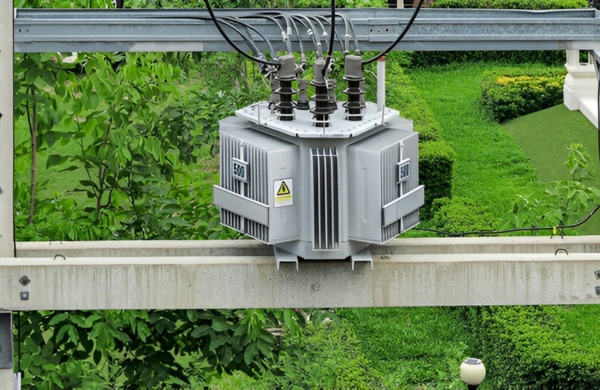As electrical systems grow larger and more complex, heat management becomes one of the most critical aspects of transformer design. Excess heat can degrade insulation, shorten equipment life, and compromise reliability — especially in high-load industrial and grid environments. That’s where oil cooled transformers come in.
Engineered for exceptional thermal efficiency and durability, oil cooled transformers provide a dependable solution for power distribution, generation, and industrial applications where performance cannot be compromised.
With decades of field-proven reliability, these transformers remain the preferred choice for utilities and EPCs seeking long-lasting power solutions.
Know About Keeping Power Cool: The Engineering Behind
Oil Cooled Transformers
Understanding Oil Cooled Transformers
An oil cooled transformer (also known as an oil-filled transformer) uses insulating oil as both a cooling medium and an electrical insulator. The oil absorbs the heat generated in the core and windings, then circulates through radiators or cooling fins, where it dissipates the heat into the surrounding air before returning to the tank.
This process ensures uniform temperature distribution and prolongs the life of windings and insulation materials.
Key Functions of Transformer Oil:
- Heat dissipation—transfers heat from active parts to radiators.
- Electrical insulation—prevents arcing and breakdowns between conductors.
- Moisture protection—seals internal components from humidity.
- Arc suppression—Extinguishes potential faults or flashovers within the tank.
Types of Cooling Systems
The cooling method is one of the most defining aspects of transformer performance. Oil cooled transformers are classified by the mode of oil and air circulation.
| Cooling Type | Description | Application |
| ONAN (Oil Natural, Air Natural) | Oil and air circulate naturally by convection. | Standard power and distribution transformers. |
| ONAF (Oil Natural, Air Forced) | Fans assist air flow to improve heat dissipation. | Medium to high-capacity transformers. |
| OFAF (Oil Forced, Air Forced) | Pumps circulate oil; fans enhance air cooling. | High MVA units and substations. |
| OFWF (Oil Forced, Water Forced) | Water cools the oil through heat exchangers. | Compact installations or enclosed environments. |
Each method balances thermal performance with installation constraints, operating environment, and power rating.
Design and Construction of Oil Cooled Transformers
Oil cooled transformers are designed for reliability under heavy electrical and mechanical stress.
Core Construction
- Built using cold rolled grain-oriented (CRGO) steel laminations for minimal hysteresis loss.
- Step-lap core joints reduce noise and magnetic flux leakage.
- Magnetic shielding prevents localized heating and stray losses.
Winding Design
- Electrolytic copper windings with multi-layer insulation for high dielectric strength.
- Radial and axial cooling ducts to facilitate uniform oil flow and temperature control.
- Rigid mechanical bracing to withstand short-circuit forces.
Insulation and Tank Design
- High-grade cellulose or synthetic insulation materials for superior dielectric endurance.
- Tanks fabricated from mild or stainless steel, with pressure-tested welds to ensure leak-proof operation.
- Radiator fins or cooling tubes attached for efficient heat transfer.
Performance Benefits of Oil Cooling Systems
1. High Thermal Efficiency
Oil’s superior thermal conductivity ensures effective cooling even under overload conditions, maintaining stable winding temperatures.
2. Extended Equipment Life
Controlled temperature rise prevents insulation aging and prolongs operational life beyond 25 years.
3. Higher Load Capacity
Efficient cooling allows for higher power ratings without increasing physical size.
4. Proven Reliability
Oil cooled transformers have demonstrated exceptional field reliability in utility, industrial, and renewable energy environments.
5. Cost Efficiency
Lower material and operational costs compared to dry-type designs, especially at higher capacities.
Applications Across Power and Industry
Oil cooled transformers are deployed in diverse and demanding sectors:
1. Power Transmission and Distribution
Used in substations to step voltage up or down for efficient power transfer across long distances.
2. Industrial and Manufacturing Plants
Support high-capacity loads such as furnaces, compressors, and conveyor systems.
3. Renewable Energy Projects
Serve as interconnection transformers for solar and wind farms, providing grid stability.
4. Railway Electrification
Supply power to traction substations and overhead systems.
5. Utilities and Smart Grids
Provide stable, low-loss power for both rural and urban grid infrastructures.
Modern Innovations in Oil Cooling Technology
Technological advancements have made oil cooling safer, cleaner, and more efficient.
1. Eco-Friendly Fluids
Manufacturers are increasingly using natural ester-based oils instead of traditional mineral oils. These are biodegradable, non-toxic, and offer higher fire points, reducing environmental risk.
2. Advanced Sealing Systems
Hermetically sealed tanks eliminate the need for external breathers, preventing oxidation and moisture ingress.
3. Smart Temperature Monitoring
IoT-based temperature and oil-level sensors enable real-time diagnostics, improving maintenance scheduling and preventing failures.
4. Compact Modular Designs
Modern transformers utilize optimized tank geometry and enhanced radiator designs for better cooling in smaller footprints — ideal for urban installations.
Testing and Quality Standards
Oil cooled transformers undergo stringent testing to ensure mechanical robustness, dielectric strength, and operational reliability.
Standard Tests Include:
- No-load and load loss tests for efficiency validation.
- Impulse and insulation testing to ensure dielectric integrity.
- Temperature rise and cooling performance verification.
- Partial discharge and sound level measurement.
- Oil quality testing for dielectric strength and moisture content.
Applicable Standards:
- IEC 60076 – Power Transformers
- IS 2026 – Transformer Testing Standards
- IEEE C57.12 – Oil-Immersed Transformers
Maintenance and Lifecycle Performance
Proper maintenance practices can significantly extend the service life of oil cooled transformers.
Regular Oil Testing
Periodic oil sampling and Dissolved Gas Analysis (DGA) detect early warning signs of insulation breakdown or overheating.
Oil Filtration and Regeneration
Filtration removes suspended particles and moisture, maintaining dielectric properties over time.
Thermal and Electrical Monitoring
Temperature indicators, pressure relief valves, and Buchholz relays ensure operational safety.
With these preventive measures, transformers can reliably operate for 30 years or more.
Zetwerk’s Engineering Expertise in Oil Cooled Transformers
Zetwerk delivers end-to-end manufacturing of oil cooled transformers, combining advanced design, material precision, and controlled production processes.
Core and Winding Fabrication
- Precision laser-cut CRGO laminations for low core losses.
- Automated winding machines ensure dimensional accuracy and mechanical strength.
Oil Processing
- In-house vacuum oil filtration and degassing facilities maintain insulation quality.
- Environmentally compliant oil handling systems ensure safe operations.
Assembly and Testing
Each unit is assembled under strict process control, followed by type and routine testing in compliance with IEC and IS standards.
Zetwerk’s oil cooled transformers are trusted across utilities, renewable energy projects, and industrial facilities for their long-term reliability and certified performance.
Benefits for EPCs and Utilities
- Custom-engineered solutions for project-specific voltage and load requirements.
- Optimized lead times through in-house design and fabrication.
- Full documentation and testing certification for project compliance.
- Sustainable and safe designs with eco-friendly oil options.
- Responsive after-sales support and lifecycle maintenance guidance.
Conclusion
Managing heat effectively is the foundation of transformer reliability — and oil cooled transformers excel at it. With unmatched cooling efficiency, superior insulation, and proven long-term performance, they remain the cornerstone of dependable power systems.
Zetwerk is one of the leading high-performance oil cooled transformers manufacturers that are engineered for endurance, precision, and compliance with global standards. Every unit is built with meticulous testing, robust materials, and advanced thermal design — ensuring years of reliable service in the world’s most demanding environments.




For infrastructure that demands stability under pressure, partner with Zetwerk — where engineered cooling turns power into lasting performance.
FAQs
a. Oil cooled transformers use oil for insulation and cooling, offering higher efficiency and capacity. Dry-type transformers rely on air or resin and are used mainly for indoor or fire-sensitive environments.
a. Regular oil testing, filtration, and thermal inspections ensure long service life.
a. Yes, modern sealed and ester-oil designs offer high safety and fire resistance.
a. 25–35 years, depending on operational conditions and maintenance frequency.
a. Absolutely. Each transformer is tailored for voltage class, cooling type, and environmental conditions.








